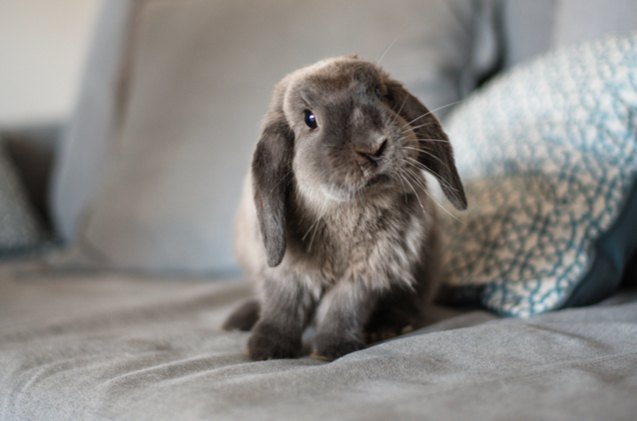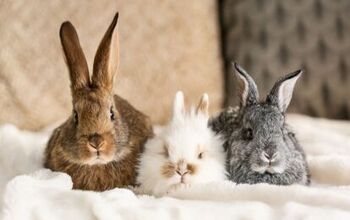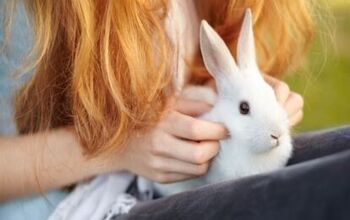10 Best Indoor Rabbits

Most, if not all, pet rabbits are kept indoors. The majority of pet rabbit breeds we’ve come to cherish as our companions are vulnerable to the outside life: they are prey to bigger and predatory animals and extreme cold or warmth can endanger them. This is why keeping your bunny in an appropriate indoor enclosure, with plenty of safe time outside of it, is the best practice. It keeps your pet safe and comfortable, and also helps you build a true bond with you. When your rabbit is close to you and spends all of their time in your presence, they will grow to be more social and relaxed around you, allowing them to express their affectionate side and allow you to pet and handle them.
If you are planning to keep a rabbit as an indoor pet, there are a few factors to consider. From the space they require to their breed characteristics, you’ll have to choose carefully to make sure your pet will thrive in your care – and that you’ll get to fully enjoy their companionship. We’ve selected the 10 best indoor rabbits to make sure any owner can find a perfect match – read on to learn more about these pet bunnies.
#1 Holland Lop Rabbit
One of the most popular indoor rabbit breeds, the Holland Lop, is best known for their floppy ears, small size, and wonderful personality. Playful, cuddly, and overall friendly rabbits, Holland Lops are a joy to be around and make lovely pets for families of all sizes. As they are classified as dwarf rabbits, they will not need an unreasonable amount of space – but be sure to provide plenty of time for play and exercise outside their enclosure, be it indoors or outside in a safe pen. They weigh 2 to 4 pounds on average and have an impressive lifespan of 7 to 14 years.
#2 Lionhead Rabbit
These pocket-sized lions are as sweet as they are cute! Distinct for the wooly mane around their head, these bunnies have a unique look that many pet owners adore, making this indoor rabbit breed one of the most popular around. Affectionate, playful, and energetic, a Lionhead is a fun and loving pet. They adore playing and will need plenty of free space to hop around and explore. They usually weigh 2.5 to 3.5 pounds and have a life expectancy of 7 to 10 years.
#3 Dwarf Hotot Rabbit
The unique looks of the Blanc de Hotot or Dwarf Hotot rabbit make a truly eye-catching bunny: pure white coat with pitch-black markings encircling their eyes, so much so they look like they have eyeliner on. But it’s not only their striking looks that make them popular pets, as they are sociable, sweet, and love to interact with their owners. Be it playing or a snuggle session, your Dwarf Hotot will love it! They are petite bunnies weighing only 2.5 to 3.5 pounds and have a lifespan of 7 to 10 years.
#4 American Fuzzy Lop Rabbit
It’s difficult not to be enamored with the fluffy, cute, and miniature American Fuzzy Lop rabbit. These bunnies boast floppy ears and fuzzy wooly coats, as well as a kind-natured temperament. They are curious, easy-going, and above all affectionate with their family – and love nothing more than playing with you or with some fun rabbit toys. These are dwarf rabbits that weigh 3.5 to 4 pounds and can live anywhere from 5 to 8 years on average.
#5 Mini Rex Rabbit
These bunnies might be diminutive in size, but the same cannot be said about their beauty! Sporting a luxurious, velvety coat as the defining trait of the breed, they are a delight to snuggle with. And they love being petted, too, as they are affectionate and calm, and love interacting with their owners. Mini Rex weighs only 3.5 to 4.5 pounds on average, so they don’t need as much space as larger breeds do. Their average lifespan is 7 to 10 years.
#6 Dutch Rabbit
Considered to be one of the older indoor rabbit breeds, the Dutch rabbit remains a popular and cherished pet to this day. Their dark markings make them stand out from other similar breeds, and their short, glossy coat makes them low-maintenance when it comes to their grooming needs. They have a calm, docile temperament, and can be very friendly and playful once they warm up to you. Weighing 4.5 to 5 pounds on average, the Dutch rabbit is classified as a mini breed, boasting a lifespan of 5 to 8 years.
#7 New Zealand Rabbit
If you have plenty of free space in your home and would like to share it with a bigger bunny, consider the New Zealand rabbit. These docile, even-tempered, sweet bunnies make fantastic companions for families of all sizes and have an easy-going personality that makes them quite adaptable when properly socialized. As a large breed rabbit, they usually weigh between 10 and 12 pounds and have a lifespan of 5 to 8 years.
Polish Rabbit
This petite charmer will quickly grow on you! The Polish rabbit is a calm, docile, kind-hearted bunny that will love being showered with affection and attention. They don’t need gigantic enclosures and are generally considered easy to care for, so they are also a good choice for first-time owners. These bunnies usually live for 5 to 6 years and weigh only 2.5 to 3.5 pounds, which puts them into the dwarf category of rabbit breeds.
#9 Himalayan Rabbit
One of the older rabbit breeds in existence, the Himalayan rabbit has a long tradition of being a beloved pet bunny. These rabbits are quite unique, both for their cylindrical body shape and white coat with contrasting markings on their feet, nose, ears, and tail. They have a calm and gentle temperament, which makes them ideal for anyone that prefers easy-going pets. A small breed rabbit, the Himalayan weighs 2.5 to 5 pounds and has a life expectancy of 5 to 8 years.
#10 Lilac Rabbit
As their name indicates, the Lilac rabbit has only one ARBA-approved color – lilac (or lavender, if you prefer). While they are not literally purple, their gray fur has an unusual shine to them, making them appear purplish – and that’s definitely unique! These rabbits are friendly, calm, docile, and make perfect companions for adults and children both, when properly socialized. They are categorized as a medium-sized breed with their average weight being 6 to 8 pounds and a long lifespan of 9 to 12 years.
A Quick Guide to Keeping Indoor Rabbits
The idea that bunnies are the ultimate low-maintenance pet is nothing more than a myth. Sure, you might not have to take them out for walks multiple times a day like you would a dog, but that doesn’t mean that they don’t have specific needs you’ll have to meet. Like all other pets, rabbits also need a quality diet, adequate living space, plenty of exercise and playtime, and a healthy relationship with their owners.
- Provide a spacious enclosure
No matter how tiny the breed of rabbit, they’ll still need a spacious enclosure to spend their time in. Nothing too cramped will do – it can seriously impact your pet’s quality of life. As a rule of thumb, their enclosure should be 4 times their size, so be sure to factor that in when choosing an indoor rabbit breed. It would mean at least 24 inches by 36 inches for the smallest bunnies. While some people opt for rabbit cages or bunny condos if they have more than one rabbit, these options are less than ideal – a puppy pen would be a much comfier fit. Alternatively, you can give your pet freedom to share your living space, with their corners for food and water bowls as well as litter, but you will have to bunny-proof your home in that case.
- Rabbit-proofing your home for their safety
Rabbits are avid chewers and are known for gnawing on everything in their sight, which can happen to be dangerous and can cost you your valuables, as well. Rabbits can chew on electric cables (they love doing that) which can be very harmful, but they also chew furniture legs, baseboards, and so on. To prevent them from doing damage to your home and potentially injuring themselves in the process, you will have to rabbit-proof your home. Remove any potentially toxic plants from the area they spend time in, use protective tubing or plastic sleeves to keep them away from cords and cables, and block off areas you don’t want them to be in with a baby gate.
- Rabbits need outdoor time
Despite your rabbit being an indoor rabbit, they’ll still have to have some quality time outside of your home. However, the same things are still true – they are vulnerable both to the elements and to the predators. When you’re letting your rabbit out, they will need to be in a safe enclosure where no predators can reach them and there’s no chance of them wandering off and getting into trouble. Also, be sure that the weather is appropriate – put the enclosure in the shade when it’s warm, and don’t let them out in extreme weather. And remember that their outside time should always be supervised!
- Their diet is very important
All creatures depend on a healthy diet to support their overall health, but rabbits are even more specific as what they eat is essential for their normal functioning. A rabbit’s teeth grow throughout their life, so their food needs to be coarse enough that it gently files down their teeth when they are chewing it. Similarly, they are very prone to GI stasis, which is a fatal condition, and need a lot of fiber in their diet to help prevent this from happening. This is why their diet consists mainly of hay – preferably timothy hay, but any other grass hay will do. In addition to hay, they should also eat a smaller quantity of rabbit pellets as well as leafy greens, to supplement their other dietary needs.
- Litter train your rabbit
While it might be more difficult to potty train your rabbit, it’s not impossible. And if they are kept indoors, it will be necessary! Rabbits like to do their business in one place, so it won’t be too difficult to point them in the right direction with plenty of patience and tasty treats as a reward for the job well done. Their litter box should have low sides so they can get in and out of it comfortably, and shouldn’t contain clay litter or silica litter as it can be harmful to them. Use paper pellets topped with hay, as bunnies love eating while peeing or pooping (weird, but it works wonders). You can also place some of their droppings into the litter to encourage them to use it, or place it in the spot they’ve used to go potty when the litter wasn’t set up.
- You should spay or neuter your rabbit
Rabbits are known as prolific breeders – but when you keep them as pets, you don’t need them to produce litter after litter. To boot, having intact rabbits that are not breeding can come with a host of other issues, such as behavioral problems and a higher risk of cancer. You can get your rabbit fixed around 6 months of age and it will be highly beneficial for their overall health, both mental and physical. Statistics show that female rabbits that are not spayed before three years of age have an 80% chance of uterine cancer, so spaying prevents that unfortunate scenario – and in males, prevents testicular cancer. What’s more, unaltered rabbits have a tendency to be moody, aggressive, and mark their territory with urine, and spaying or neutering them on time will prevent all of these negative behaviors.

A proud mama to seven dogs and ten cats, Angela spends her days writing for her fellow pet parents and pampering her furballs, all of whom are rescues. When she's not gushing over her adorable cats or playing with her dogs, she can be found curled up with a good fantasy book.
More by Angela Vuckovic
































